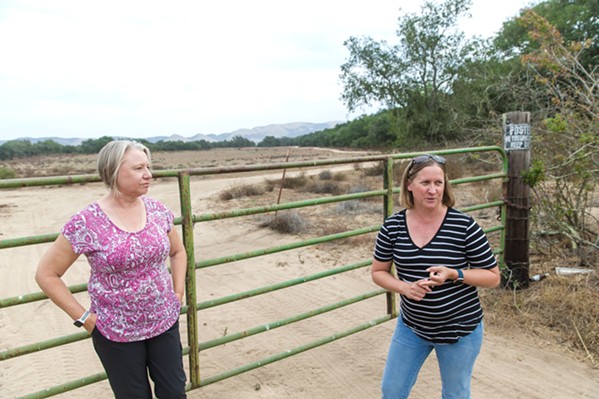Local residents express concerns over future loss of natural habitat, oak trees to build the Dana Reserve project in Nipomo
By Samantha Herrera[{
"name": "Newsletter Promo",
"id": "NewsletterPromo",
"class": "inlineCenter",
"insertPoint": "4",
"component": "15264767",
"requiredCountToDisplay": "0"
},{
"name": "Ad - Medium Rectangle CC01 - 300x250",
"id": "AdMediumRectangleCC01300x250",
"class": "inlineCenter",
"insertPoint": "8",
"component": "2963441",
"requiredCountToDisplay": "12"
},{
"name": "Ad - Medium Rectangle LC01 - 300x250",
"id": "AdMediumRectangleCC01300x250",
"class": "inlineCenter",
"insertPoint": "18",
"component": "2963441",
"requiredCountToDisplay": "22"
},{
"name": "Ad - Medium Rectangle LC09 - 300x250",
"id": "AdMediumRectangleLC09300x250",
"class": "inlineCenter",
"insertPoint": "28",
"component": "3252660",
"requiredCountToDisplay": "32"
}]
A Nipomo development reduced the number of oak trees it would cut down, but the Dana Reserve project still asks to remove a little more than 3,000 oak trees from its 288-acre property.
Community members and local environmentalists think that number continues to be far too high.
San Luis Obispo County's biggest housing development in 25 years plans to cut down approximately 3,094 oak tees, Burton Mesa chaparral habitat, and other nonnative grasslands to help make room for its 1,318 residential units, 203,000 square feet of recreational space, village shopping center, California Fresh Market grocery store, South County Cuesta College campus, and neighborhood parks, according to the staff report.
Project developers Nick Tompkins and his daughter Elizabeth said that the project will also be planting more than 1,000 new oak trees and is retaining hundreds of others, leaving a total of 4,202 oak trees on-site after the project is complete.
"For the total number of trees impacted for each home that is built at the Dana Reserve, 2.1 oak trees will be removed. However, through the oak tree mitigation plan with both on-site and off-site conservation and on-site replanting, 11.8 trees will remain for each home build," Elizabeth said during the Oct. 23 SLO County Planning Commission meeting. "Another way to say this is that for every tree impacted, 5.6 will be permanently protected."
The public hearing went on for two days, Oct. 23 and 24, and commissioners ultimately voted 4-1 to propose that the SLO County Board of Supervisors approve the project at an upcoming meeting that's yet to be announced. Planning Commissioner Anne Wyatt dissented.
While some SLO County residents support the removal plan in order to build more housing and create job opportunities on the Central Coast, others such as Herb Kandel with the Nipomo Action Committee want to encourage project developers to keep looking at alternative plans and continue reducing the number of oak trees and native plant life that need to be cut down.
"It starts with a plan that keeps a reasonable amount of habitat in place," Kandel told New Times. "Then we can build on the final [environmental impact report] to include a mixed housing development that includes affordable housing. This shows there can be an opportunity to protect both habitat and produce affordable housing."
Kandel said that oak trees bring a variety of benefits to residents not just in Nipomo but all around the county that other plants just can't re-create, such as quickly replenishing the groundwater basin.
"Oak forests are slower to deteriorate so they percolate water more effectively back into the groundwater table," he said.
Bill Waycott, fieldtrip coordinator for SLO Chapter of the California Native Plants Society, told New Times that Nipomo is special because it sits on an ancient oak forest, but today there's only 5 percent of untouched oak forest left. Keeping it protected, he said, is valuable for the environment and for honoring the history of Nipomo.
"It's estimated that about 12,000 years ago, these large sand dunes formed as a result of the last ice age and there was a lot of erosion at that time, to which sand was blown into these cracks from the ocean and created a large sand dune. It was a huge sort of landscaping factor," Waycott said. "Due to this unique soil structure in Nipomo, chaparral plants and oak woodlands developed in their own way on this sand dune, and they're rare."
Waycott said that oak trees are also resilient.
"They can survive on not a lot of water and they're green all year round, which is great," he said. "Green means photosynthesis and that means absorbing CO2 and giving off oxygen all year long."
Cleaning the air of carbon while replenishing it with oxygen is a key priority for Dana Reserve developers, according to county staff, which is why they want to plant around 1,500 new oak trees as part of the development.
"It's been generally described to me from several different experts that young trees actually sequester more carbon than older, mature, larger trees because the greatest potential to sequester is through that growth phase," county staff member Emily Creel said during the Oct. 23 meeting. "It's a complicated issue, one in which the clear solution is to preserve as many trees as you can and continue to plant new ones."
However, Waycott said that a loss of mature habitat and waiting years to decades for new trees to grow could lead to an uptick in rodents and other animals that community members don't want in their neighborhood.
"[Losing oak trees] means losing predator species, which control rodents that are living under these trees. Then we lose bunnies and squirrels, and then what's left?" he said. "Raccoons and skunks and things that you know people don't really like anyways."
While staff discussed requiring homeowners in the Dana Reserve to plant and care for an oak tree for a minimum of seven years, former Cal Poly professor David Chipping told New Times that it's not a well thought-out plan.
"So if at the end of the seven years, the homeowners association says, 'These trees are making a mess in the sidewalk, or they are cracking the roads, or they look a little dirty, let's tear them down,' then there's no long-term guarantee to tend to these trees beyond the seven years," Chipping said. "An oak isn't a good tree to grow in a street anyways; they grow quite slowly and they tend to have roots that can sort of break the local paving."
Waycott agreed and added that growing an oak in a confined area can end up damaging the tree.
"Concrete, pavement, and even cars parked on the ground under the oak tree are going to impact the soil and it's going to reduce the oxygen to the roots and water," he said. "So that's definitely going to have a huge impact."
While agreeing that there needs to be some housing built for the increasing population in SLO County, Waycott said he hopes to see some more research conducted while moving the housing project to an area that doesn't affect as many native plants.
"Now, the question is, how can we influence [developer's] decisions by promoting alternatives to the plan that will save as much [native plant life] as we can save," Waycott said. Δ
Reach Staff Writer Samantha Herrera at [email protected].
Latest in News
Readers also liked…
-

Coast Unified teachers upset over new position's salary and qualifications
Oct 20, 2022 -

SLO police identify alleged driver who hit and killed couple
Dec 22, 2022 -

When the levee breaks: Oceano residents, county officials walk a tightrope of regulations to manage Arroyo Grande Creek, which some say led to the levee's failure in January
May 18, 2023










